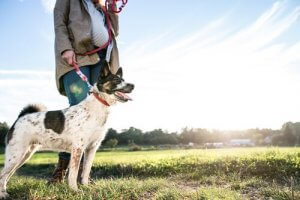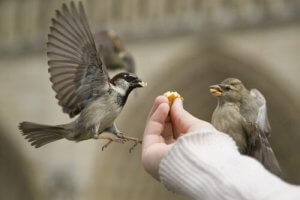The Special Relationship Between Animals and Humans

There has always been a special relationship between animals and humans. But, sometimes, you hear stories that go far beyond anything you’ve heard or seen before. In today’s article, we’ll be telling you one such story. This is a clear example of just how incredible the connection between humans and animals really is.
Birds and humans: a special relationship
Five hundred years ago, a Portuguese missionary in Mozambique realized that a small bird was slipping through the cracks in the walls and doors of his church to peck at the wax of the candles.
Records also reported that the birds would guide the man towards bee hives so he could collect honey. The birds could then eat the leftovers.

Today, this story has been proven to be true. What’s more, it represents a fascinating example of the communication between humans and animals.
Apparently, they make an incredible team. These particular birds, known as honeyguides, have an incredible ability to seek out beehives. Humans can then use smoke to drive the bees out of the hives. A single sting can be fatal to the honeyguide, but by working with humans, they can get at the honey with no risk of getting stung.
But how do these birds know when the humans need their help? One local tribe, the Yao, make a high-pitched sound that they teach the birds to recognize. This sound tells them the honeyguides they are needed.
Investigators wanted to know if this sound could be used in other situations, with negative results. However, when they used the sound with the aim of using the birds to find honey, the honeyguides cooperated almost 70% of the time.
Surprising scientific results
These are the results as recorded by scientists:
“These results show that a wild animal correctly attaches meaning and responds appropriately to a human signal of recruitment toward cooperative foraging… A behavior previously associated with only domestic animals, such as dogs. The honeyguide-human relationship is notable in that it involves free-living wild animals whose interactions with humans have probably evolved through natural selection. With domesticated animals, humans have altered their genetic material, selecting characteristics that are useful to them. Although humans use many species as foraging partners, including falcons, dogs, and cormorants, these involve trained or domesticated individuals that are specifically taught to cooperate. With honeyguides however, we have wild animals who cooperate with humans without any interference from people.”
As you can see, despite other cases of cooperation between humans and animals, the case of the honeyguide is particularly unusual. In fact, the only comparable relationship involves the cooperation between dolphins and fishermen. However, this is something that is rapidly disappearing. Far from helping us, humans now generate such terror amongst dolphins that they just want us to stay as far away as possible.

The future
Whether it be using them for work, making them participate in bull runs, or forcing them to fight other animals for entertainment, abuse is slowly driving animals further and further away from humanity.
So let’s fight it. Alone, it might not seem like you can make a difference. But if every single one of us does our part, we might be able to leave a better world for generations to come. A world in which animals and humans can peacefully coexist and help one another. And create a better world. After all, isn’t that what everyone wants? And we can all do something to bring this world one step closer. So, let’s fight to make this world better for both animals, and ourselves.
There has always been a special relationship between animals and humans. But, sometimes, you hear stories that go far beyond anything you’ve heard or seen before. In today’s article, we’ll be telling you one such story. This is a clear example of just how incredible the connection between humans and animals really is.
Birds and humans: a special relationship
Five hundred years ago, a Portuguese missionary in Mozambique realized that a small bird was slipping through the cracks in the walls and doors of his church to peck at the wax of the candles.
Records also reported that the birds would guide the man towards bee hives so he could collect honey. The birds could then eat the leftovers.

Today, this story has been proven to be true. What’s more, it represents a fascinating example of the communication between humans and animals.
Apparently, they make an incredible team. These particular birds, known as honeyguides, have an incredible ability to seek out beehives. Humans can then use smoke to drive the bees out of the hives. A single sting can be fatal to the honeyguide, but by working with humans, they can get at the honey with no risk of getting stung.
But how do these birds know when the humans need their help? One local tribe, the Yao, make a high-pitched sound that they teach the birds to recognize. This sound tells them the honeyguides they are needed.
Investigators wanted to know if this sound could be used in other situations, with negative results. However, when they used the sound with the aim of using the birds to find honey, the honeyguides cooperated almost 70% of the time.
Surprising scientific results
These are the results as recorded by scientists:
“These results show that a wild animal correctly attaches meaning and responds appropriately to a human signal of recruitment toward cooperative foraging… A behavior previously associated with only domestic animals, such as dogs. The honeyguide-human relationship is notable in that it involves free-living wild animals whose interactions with humans have probably evolved through natural selection. With domesticated animals, humans have altered their genetic material, selecting characteristics that are useful to them. Although humans use many species as foraging partners, including falcons, dogs, and cormorants, these involve trained or domesticated individuals that are specifically taught to cooperate. With honeyguides however, we have wild animals who cooperate with humans without any interference from people.”
As you can see, despite other cases of cooperation between humans and animals, the case of the honeyguide is particularly unusual. In fact, the only comparable relationship involves the cooperation between dolphins and fishermen. However, this is something that is rapidly disappearing. Far from helping us, humans now generate such terror amongst dolphins that they just want us to stay as far away as possible.

The future
Whether it be using them for work, making them participate in bull runs, or forcing them to fight other animals for entertainment, abuse is slowly driving animals further and further away from humanity.
So let’s fight it. Alone, it might not seem like you can make a difference. But if every single one of us does our part, we might be able to leave a better world for generations to come. A world in which animals and humans can peacefully coexist and help one another. And create a better world. After all, isn’t that what everyone wants? And we can all do something to bring this world one step closer. So, let’s fight to make this world better for both animals, and ourselves.
This text is provided for informational purposes only and does not replace consultation with a professional. If in doubt, consult your specialist.








